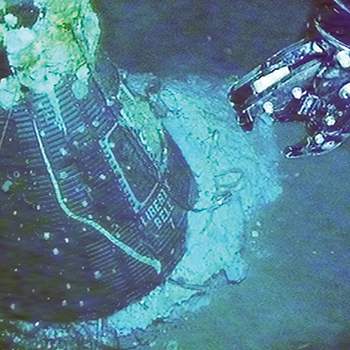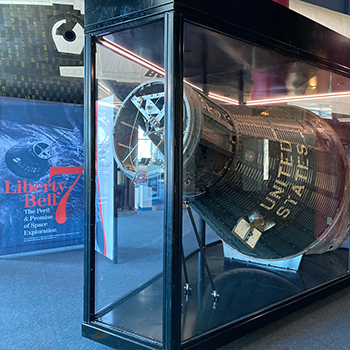Join us July 20 and 21 for the 59th anniversary of Liberty Bell 7 during the Cosmosphere’s Summer Space Splashdown!
Learn more about the mission and the craft that sent the second US astronaut into space in our blog piece listed below and then see the Discovery Channel documentary: “In Search of Liberty Bell 7” in the Grand Lobby. Watch Cosmosphere social media for fun facts and more mission history on the craft as well!
On Tuesday, July 21, at 3:00 p.m. (CDT)—Cosmosphere curator, Shannon Whetzel will offer a behind-the-scenes presentation on the Cosmosphere’s Facebook page featuring Liberty Bell 7 artifacts that are not on public display.
Whether visiting in person, or online, be sure to pick up a celebratory Liberty Bell 7 anniversary shirt in our gift store here.
Limited Edition T-Shirt Series Available: First Shirt Launches July 21!
It’s the Summer Space Splashdown! Purchase a Summer Space Splashdown T-Shirt from our upcoming Spacecraft Collector Series and support the Cosmosphere!

Beginning July 21 (the anniversary of Liberty Bell 7’s mission) get the first shirt in the series: Liberty Bell 7.
There’s only one place in the Midwest you can see a flown Mercury, Gemini and Apollo spacecraft. It’s the Cosmosphere in Hutchinson, KS! This series of t-shirts celebrates the spacecraft in the Cosmosphere collection and stories that end with a SPLASH.
Watch for the release date of each unique design in the three shirt series. Collect them all in every color and support the world’s most incredible science education center and space museum!
The Cosmosphere thanks its lucky stars for every purchase and hopes you’ll come see these spacecraft in real life soon!
Link for the first shirt coming July 21!
About Liberty Bell 7
The Flight
On July 21, 1961, with a 15-minute suborbital flight of the Mercury spacecraft Liberty Bell 7, Gus Grissom became the second American in space. The flight was by-the-book until splashdown when the explosive-powered hatch jettisoned prematurely, flooding the capsule and Grissom’s space suit. Grissom scrambled out of the spacecraft and nearly drowned in the swells. With the spacecraft full of water, the weight was too much for the recovery helicopter. Liberty Bell 7 was released and the spacecraft sank nearly three miles to the bottom of the Atlantic.

38 Years on the Ocean Floor
The Cosmosphere began its efforts to recover Liberty Bell 7 in 1978 when looking for a Mercury spacecraft for the Cosmosphere’s Hall of Space Museum. The only “unclaimed” flown Mercury at the time was Liberty Bell 7, but it was more than 16,000 feet below sea level—deeper than the Titanic—and the technology needed to recover the spacecraft from that depth was not commercially available. In the meantime, the Cosmosphere found a Mercury spacecraft for display, but still held on to the dream of recovering Liberty Bell 7.

In 1986, the Cosmosphere joined forces with deep-sea salvage expert Curt Newport. Enlisting the help of hundreds of engineers, scientists, historians and oceanographic technicians, the location of Liberty Bell 7 was determined. The team of experts studied ship logs and conducted interviews with people involved in the flight and recovery to determine the location of the spacecraft. They looked at weather and tide data and did computer studies to determine how the spacecraft sank and where it might be. They studied the unique metals of the Mercury capsule to calculate the possible corrosion occurring in salt water at 16,000 feet. The variables were numerous, but searchers were confident that they had narrowed the search area to approximately one mile in diameter and would find the spacecraft in good condition.
Because of the expense of the project—and the fact that the exact location of the spacecraft was still unknown—the project was shelved until 1999, when the Discovery Channel underwrote a large-scale expedition dedicated to finding and recovering Liberty Bell 7.
The Expedition
A deep-sea salvage expedition funded by the Discovery Channel left Cape Canaveral on April 16, 1999. After days of meticulously exploring the 24-square-mile search area 300 miles off the coast of Florida with a side-scan sonar, the crew had mapped 88 potential targets. They narrowed their search down to 18 targets on which they would dive with a Remote Operated Vehicle (ROV) outfitted with high-definition cameras. The first target they dove on was Liberty Bell 7. But their excitement was short-lived when the tether of the ROV was severed in extremely rough sea conditions and the ROV fell to the bottom of the ocean, effectively ending the expedition.


A new ROV was built and a second expedition mounted to retrieve Liberty Bell 7 on July 1, 1999. The spacecraft was recovered from the ocean floor and returned to Port Canaveral on July 21, exactly 38 years after its flight into space. The drama of the expedition was captured in the two-hour Discovery Channel documentary In Search of Liberty Bell 7. Watch the Discovery Channel’s In Search of Liberty Bell 7 here.
Restoring and Preserving Liberty Bell 7
Upon its arrival in Hutchinson the spacecraft was continuously flushed with fresh water to begin the long process of cleaning the salt from the entire system. The meticulous six-month restoration took place in a restoration/exhibit area in the Cosmosphere’s Hall of Space Museum in full view of the public. Additionally, a live webcam in the restoration area allowed millions of people around the world to watch the historic restoration.

To ensure that all the salt and corrosive elements were removed from the spacecraft, every one of the approximately 25,000 parts were removed, disassembled, cleaned and then put back together. The goal of the project was not to make the spacecraft look brand new, but to clean and preserve it so that it would be available for generations to come. If the salt and corrosive elements were not removed, the spacecraft would have rapidly deteriorated when exposed to a natural air environment.

The Cosmosphere maintains the world’s premier space artifact restoration program. With more than 100 major projects to its credit, the Cosmosphere is the worldwide leader in this unique science it pioneered more than 20 years ago. Dating back to 1979 and the restoration of Gemini spacecraft no. 2, the Cosmosphere has been called on by museums around the world to restore and preserve space history. Its projects have included nearly all major space artifact restoration projects for the Smithsonian Institution’s National Air and Space Museum, as well as artifacts for NASA.
Loans & Display
In the spring of 2020, Liberty Bell 7 returned to the Cosmosphere following more than six years of touring the world. It will be on display in the Cosmosphere’s lobby through the remainder of the year, with a South American tour currently being planned to take place in 2021.
Liberty Bell 7 is owned by the Cosmosphere, making it the worlds only privately owned American spacecraft. The Cosmosphere is among only four museums worldwide to have a flown set of manned Mercury, Gemini, and Apollo spacecraft.

Liberty Bell 7 Fun Facts
- Gus Grissom’s Liberty Bell 7 flight (sub-orbital) took place on July 21, 1961, and only lasted 15 minutes.
- It was a textbook mission until splashdown, when the spacecraft’s hatch door prematurely ejected off the craft— allowing it to fill with seawater and nearly drowning Grissom.
- Due to the hatch mis-hap, the craft sank to the bottom of the Atlantic ocean and stayed there for 38 years.
- In 1999, an expedition to recover the craft from its resting place more than 16,000 feet deep—deeper than the Titanic— was led by the Discovery Channel and the Cosmosphere.
- The spacecraft was recovered on July 20, 1999— the 30th anniversary of Man walking on the Moon!
- It took the Cosmosphere’s SpaceWorks team nearly six months to fully restore the craft to the condition you see it in today— as its entire system had to first be flushed of salt water and then corrosion removed from its 25,000 parts.
- The Liberty Bell 7 spacecraft is owned by the Cosmosphere—making it the ONLY privately owned spacecraft in the world! It also makes the Cosmosphere the ONLY place in the Midwest where visitors can see a flown craft from each early spaceflight program: Mercury: Liberty Bell 7, Gemini: Gemini X and Apollo: Apollo 13’s Odyssey.
Find out more about Liberty Bell 7 here.



